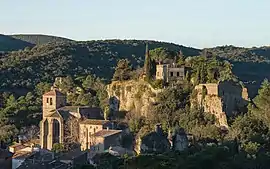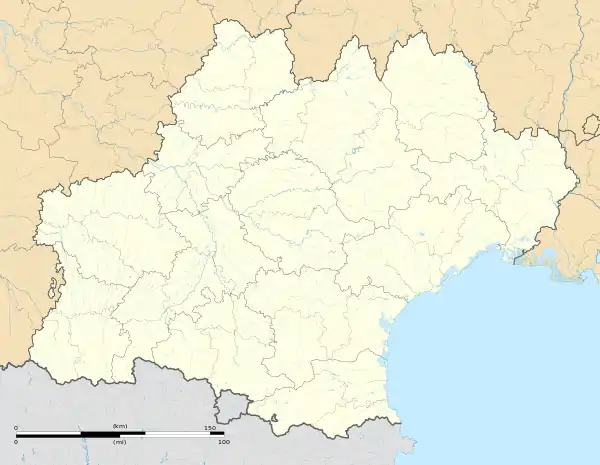Mourèze | |
|---|---|
 The village. | |
.svg.png.webp) Coat of arms | |
Location of Mourèze | |
 Mourèze  Mourèze | |
| Coordinates: 43°37′12″N 3°21′24″E / 43.62°N 3.3567°E | |
| Country | France |
| Region | Occitania |
| Department | Hérault |
| Arrondissement | Lodève |
| Canton | Clermont-l'Hérault |
| Intercommunality | Clermontais |
| Government | |
| • Mayor (2020–2026) | Serge Didelet[1] |
| Area 1 | 13.44 km2 (5.19 sq mi) |
| Population | 204 |
| • Density | 15/km2 (39/sq mi) |
| Time zone | UTC+01:00 (CET) |
| • Summer (DST) | UTC+02:00 (CEST) |
| INSEE/Postal code | 34175 /34800 |
| Elevation | 160–537 m (525–1,762 ft) (avg. 200 m or 660 ft) |
| 1 French Land Register data, which excludes lakes, ponds, glaciers > 1 km2 (0.386 sq mi or 247 acres) and river estuaries. | |
Mourèze (French pronunciation: [muʁɛz]; Occitan: Morese) is a commune in the Hérault department in the Occitanie region in southern France.
At the edge of the village are spectacular dolomitic limestone formations known as the Cirque de Mourèze.
Population
| Year | Pop. | ±% |
|---|---|---|
| 1962 | 71 | — |
| 1968 | 81 | +14.1% |
| 1975 | 79 | −2.5% |
| 1982 | 76 | −3.8% |
| 1990 | 100 | +31.6% |
| 1999 | 128 | +28.0% |
| 2008 | 171 | +33.6% |
 The Cirque de Mourèze is a steephead valley whose chaotic appearance was caused by the erosion of dolomite rocks.
The Cirque de Mourèze is a steephead valley whose chaotic appearance was caused by the erosion of dolomite rocks. An erosional remnant of dolomite in the Cirque de Mourèze
An erosional remnant of dolomite in the Cirque de Mourèze
See also
References
- ↑ "Répertoire national des élus: les maires". data.gouv.fr, Plateforme ouverte des données publiques françaises (in French). 9 August 2021.
- ↑ "Populations légales 2021". The National Institute of Statistics and Economic Studies. 28 December 2023.
Wikimedia Commons has media related to Mourèze.
This article is issued from Wikipedia. The text is licensed under Creative Commons - Attribution - Sharealike. Additional terms may apply for the media files.